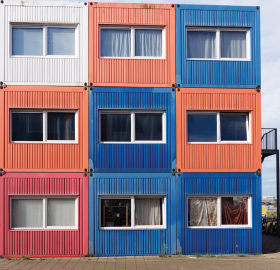Living in a steel box: are shipping containers really the future of housing?
From London to Amsterdam to Mumbai, shipping containers have been accepted as a cheap and easy way to provide housing. But what is it like to live in one, and can they be a permanent solution for housing?
It takes time to adjust to living inside a steel box. Timothy Ader did not, initially, like the idea of staying at Wenckehof, a student village in Amsterdam made up of 1,000 recycled shipping containers. But three years after moving in, he has no regrets.
“My first impression of the containers was, ‘It’s ghetto stuff – I’m not living there,’” says the 24-year-old. “But I started visiting a friend of mine living here and started to like the place. Then I moved in and I realised how good it was. I’m really comfortable in my container and I have a lot of space of my own. I wouldn’t want to live anywhere else in the world right now.”
The Wenckehof, completed back in 2006 and formerly known as Keetwonen, remains the largest development of its kind anywhere in the world. Although they built it as a temporary housing experiment, it proved so popular with students that the authorities in Amsterdam gave it permanent status in 2011.
In Berlin, students have been using shipping containers for accommodation, and, more recently, to house asylum seekers. In London, Forest YMCA has begun moving young working adults struggling to pay high rents and at risk of becoming homeless into these containers in Walthamstow– though occupants can only stay for a maximum of one year.
So what’s it like to actually live in one? Ader says his Amsterdam container is cosy: each one has living space, a bathroom and a balcony as well as insulated panels and radiators to help keep the place warm in winter. Privacy has not been a
problem. In fact, Ader found it too quiet. He helped organise block parties and “eat with your neighbour” events to make Wenckebachweg a little livelier.
It’s also cheap. Residents here pay €450 a month (£335) and also qualify for a €140 monthly housing subsidy, making it much less expensive than the €600 a month it costs to share a flat in Amsterdam.

